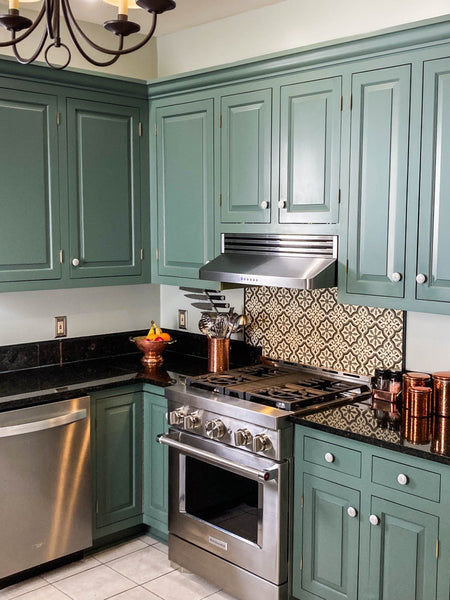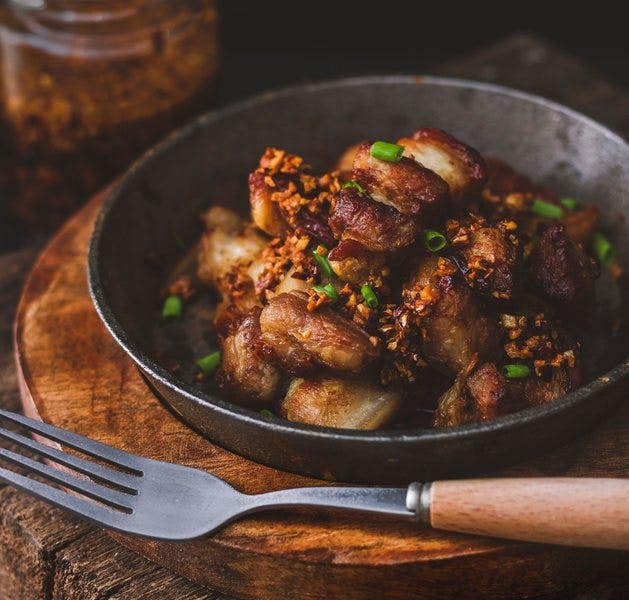As you cook with cast iron in your kitchen under your wall mount range hood, food will stick to the bottom of the pan. Whether you’re searing steak, frying chicken, or sautéing onions, don’t just scrape it all into the garbage. Instead, you can try a technique called deglazing.
What is deglazing?
Deglazing a cast iron skillet involves adding chicken stock or wine to a pan with food stuck on the bottom. After roasting vegetables or searing meats, a “fond” develops on the bottom of the pan. As the liquid heats up, it breaks down the stuck-on food. You can make delicious sauces, soups, gravies, and much more.
Here’s a quick video showing you how it works.
So when might you want to deglaze? After searing or roasting your food (commonly meat or vegetables), a tough layer of food will stick to the bottom of the pan. In cooking, this is called a “fond.”
As long as it’s not burnt to the pan, you can use this to create a sauce. If you deglaze burnt food residue, you’ll lose a lot of the flavor. It won’t taste good at all! Avoid non-stick pans when deglazing. With a non-stick pan, food won’t stick to the bottom so you won’t be able to make a flavorful sauce.
Deglazing works best in a seasoned carbon steel or cast iron skillet. Keep reading and we’ll show you how to season your cast iron pan. But first here’s how to deglaze a cast iron skillet.
What You Need
- A delicious dish (steak, chicken, vegetables, and the like)
- Chicken broth, water, beer, wine, or other base
- Cast iron skillet
- Stovetop
- Whisk
- Gravy or sauce mix (optional)
- Flour (optional)
1. Sear or roast your steak, poultry, or vegetables.
The first step is to cook your dish until it reaches a desired internal temperature.
2. Remove your dish from the pan.
You can pour out excess fat if you’re making a thin sauce.
3. Remove the pan from heat and add your liquid.
Deglazing is meant to add a burst of flavor to your dish, so chicken broth and beer are popular choices. Water is easy but it doesn’t add flavor like alcohol or chicken stock would. Vinegar and wine are great options too as long as your pan is seasoned.
4. Turn the heat to medium and lightly scrape the bottom of your pan with a spatula.
5. Thicken the sauce as desired.
To make thicker gravies, you can sometimes add flour or sauce packets to the liquid. But only if you want the thick consistency.
6. Whisk the sauce until you achieve your desired consistency.
After you add your thickening agent, whisk the sauce.
7. Give it a taste!
Now for the moment of truth! How’s your sauce taste? If it didn’t turn out quite how you like, experiment with a different base. Pretty much any liquid from water to chicken stock to beer can be used to deglaze your cast iron skillet.
Keep in mind if you deglaze your cast iron pan with vinegar or wine, it will eat away at the seasoning. You can do this if you reseason your pan regularly. But otherwise, avoid acidic liquids.
What can I use to deglaze a cast iron pan?
You have several options to deglaze a cast iron pan: chicken stock, beef stock, lime juice, and beer are all popular options. Make sure your pan is completely seasoned if you want to use acidic liquids like vinegar and wine. Water is not ideal because it doesn’t add flavor to your sauce.
Can you deglaze cast iron with water?
It’s not recommended to deglaze cast iron with water. It doesn’t add flavor like chicken broth or beef stock does. If you use the water for cooking beans or another dish, you can get some flavor from deglazing with it.
Can you deglaze cast iron with vinegar?
Yes, but vinegar is acidic, so make sure your pan is well seasoned. Using vinegar won’t damage the seasoning, since deglazing only takes a few minutes.
Can you deglaze cast iron with wine?
Yes. Like vinegar, wine is acidic. So make sure your pan is well-seasoned. White and red wine are both popular deglazing agents.
Can you deglaze cast iron with beer?
Yes, but make sure your pan is well seasoned. Beer is not as acidic as wine but it can still damage an unseasoned cast iron pan.
Can you deglaze cast iron with chicken broth?
Yes, chicken and beef broth are great liquids for deglazing cast iron.
Can you deglaze a nonstick pan?
No, don’t deglaze in a non-stick pan. Deglazing requires bits of food to stick to the bottom of the pan. That is what gives the sauce its flavor. If nothing sticks to the pan, you won’t end up with a flavorful sauce.
Is deglazing a pan bad for it?
No. If you’re deglazing with vinegar, wine, or other acidic liquids, season your pan first. Otherwise deglazing will ruin the finish.
How do you deglaze a pan without warping it?
Make sure to add room temperature water or warmer to the pan. Cold water is more likely to warp when it comes into contact with a hot pan. You can also let the pan cool for a few minutes before adding the water. Then turn on the heat after adding the liquid.
How to Reseason a Cast Iron Skillet

You can reseason your cast iron skillet on the stovetop or in the oven. Here’s a quick guide to the oven method.
Keep in mind if your cast iron has a wooden handle, you’ll need to season it on your stovetop.
1. Clean your skillet.
It shouldn’t have any food, grease, or oil on it.
2. Preheat the oven to 350º.
Dry the pan thoroughly with a dish towel or paper towels.
3. Coat the outside and inside of the pan with a thin layer of canola oil.
Make sure the pan is dry before you coat it with oil. Remember to coat the bottom of your pan as well as the handle.
4. Set the pan upside down on your stove for one hour.
Put a piece of foil on a baking sheet under the pan to catch the oil that drips down during the seasoning process.
5. Let the pan cool for one hour.
To be safe, don’t rush to remove the pan from your stove. Just let it cool for at least an hour before you store it.
That wraps up our guide on how to deglaze a cast iron skillet. How did your dish turn out? Did deglazing add flavor? We hope so!
Have fun cooking!
Related Articles
What size cast iron skillet should I buy?
How to Store Cast Iron (And Where to Store It)
How to Remove Rust from Cast Iron (Step-by-Step Guide)












